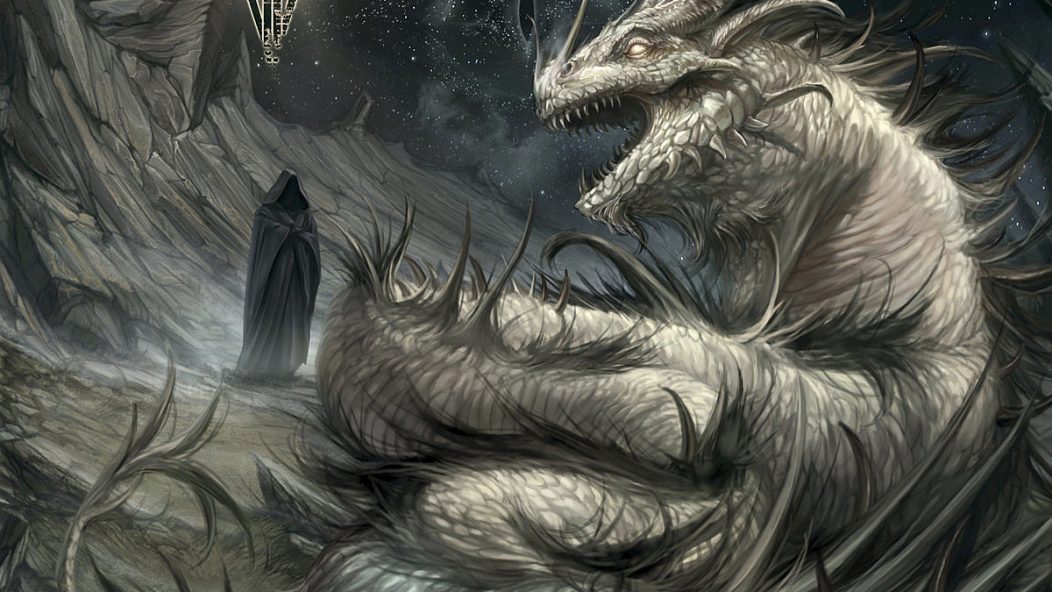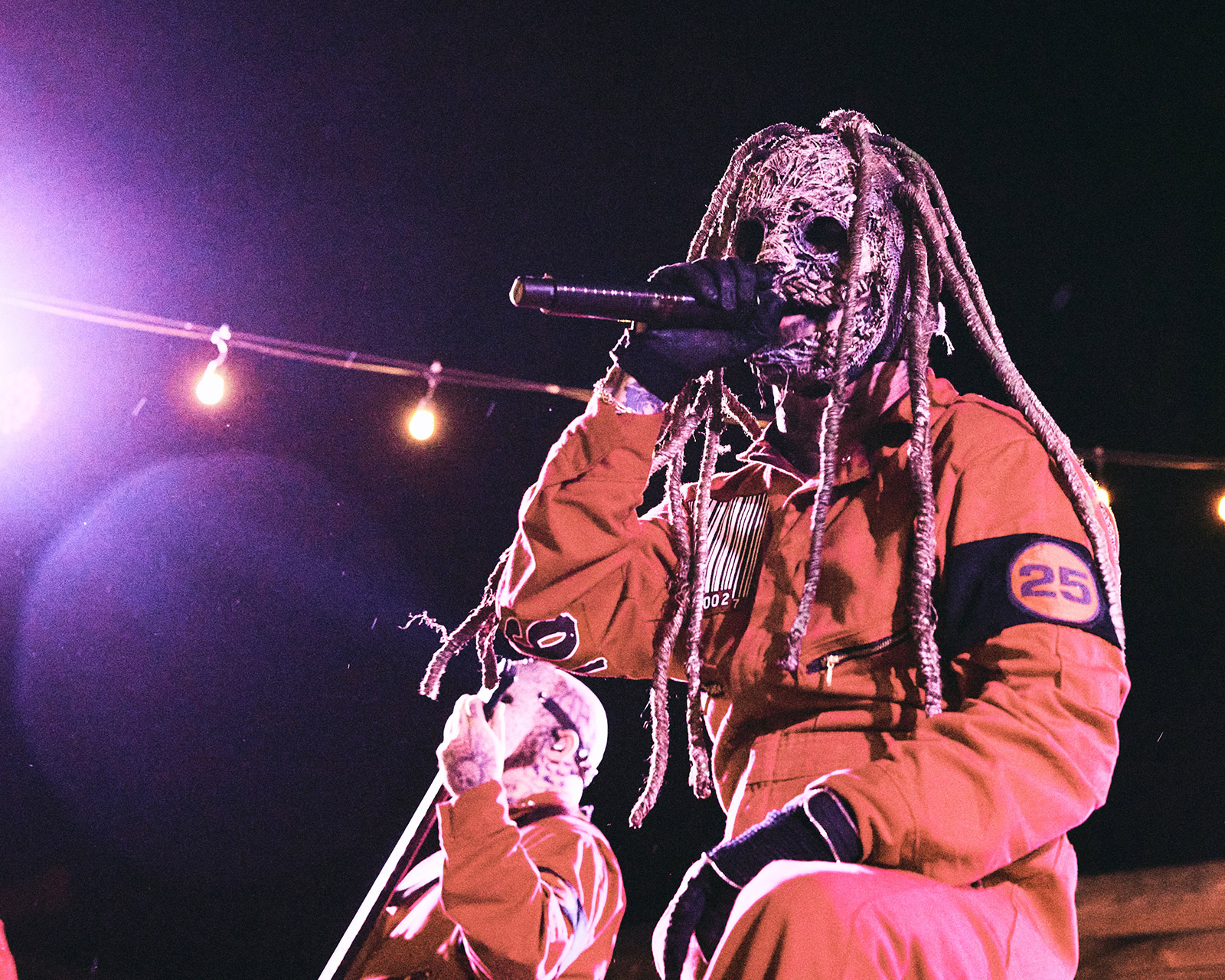
Progressively Technical: Contrarian's Seam-Busting "Their Worm Never Dies"

…
This year has provided an absolute wealth of innovative new entries in the annals of technical and progressive death metal — with many outstanding albums already released over the past three months (and dozens more announced for spring and summer), the genre appears to be growing more prolific than ever. But among this company of racers toward unexplored frontiers, a dark horse has gone unnoticed: the esoteric Contrarian, celebrating today’s release of their third full-length album Their Worm Never Dies. The band is a more experimental and melodic side-project of Nile drummer George Kollias and one of tech-death’s best-kept secrets.
Despite impressive studio material and the considerable renown of its members, the group has largely flown under the radar in the five years since its inception; formed as a collaboration between Kollias, guitarist Leon Macey of Mithras, and vocalist Cody McConnell of Goemagot, the project originally focused on marrying the styles of slamming brutal death metal and atmospheric tech, culminating in the sci-fi-oriented 2015 full-length Polemic which struck a sonic balance similar to the wave of gutturally ambient bands sweeping the subgenre at that time. However, with Macey departing the group soon after the album’s release and McConnell then stepping down to a reduced level of involvement (he now performs with the band solely in a live capacity), Kollias promptly transformed the outfit into a radically different animal with the intention of repurposing old school death metal into more forward-thinking modern interpretations of the style that display authentic novelty while retaining a clear understanding of the foundation upon which they were built.
Released in July 2017, Contrarian’s second album To Perceive is to Suffer saw the band taking massive steps to achieve this goal, successfully honing their sound into an effective mixture of modern production, unconventional song structures, and OSDM-flavored riffs and timbres. Rooted in the compositional style of early 1990’s progressive death metal but with a somewhat more experimental approach, their re-invented sound performs a nostalgic salute to genre pioneers such as Death, Atheist, and Cynic while maintaining a compelling sense of modernity. Having quickly and effectively adapted to this new methodology, Contrarian’s identity soon congealed into a more tangible and consistent form containing the elements with which they would begin to construct future material.
…
…
Now, after another two-year interval, the group returns to showcase the continuation and expansion of this venture with Their Worm Never Dies, their latest effort in uncanny temporal juxtaposition. Though it features only seven tracks and a relatively modest runtime of 37 minutes, the album is set to be Contrarian’s longest release yet, and marks a pivotal juncture for the group: if they intend to remain true to their self-professed mission statement of creating “authentically novel” death metal, this new record should not only demonstrate mastery of the techniques invented on To Perceive is to Suffer, but also a widened range of creative new ideas and concepts implemented in the quest for forward progression — not just of not their own sound, but of contemporary prog and tech-death as a whole.
The album’s opening track “Vaskania (The Evil Eye)” begins in media res, launching directly into a hypnotically serpentine odd-metered riff underlain by scattered spirals of percussion and an undulating, intricately woven bassline. In a jarring transition, the song’s pace accelerates into a vivacious and grimy double-bass death-march, with Kollias providing his snarled mid-register screech over a steady, even rhythmic pulse; the remainder of this first track alternates between variations of the introductory riff and its heavier latter counterpart until a whirlwind solo erupts from the hands of guitarist Jim Tasikas, closing out the piece.
These sudden shifts in speed and intensity characterize Their Worm Never Dies entirely, with many of its compositions based on a similarly alternating two-part structure: as if to immediately re-iterate this pattern, the album’s second track “Exorcism” commences with a clean, melancholic intro that mutates into another savagely triumphant death metal assault, then reverts into its original form as the track gently fades into silence. Furthermore, the haphazard nature of the album’s first movements displays the emphasis Contrarian has placed on the progressive elements within the album: although their previous records are both thoroughly prog-infused, this endeavor sees the band’s material essentially revolving around the experimental nature of its compositions.
The caliber of performance on Their Worm Never Dies is undeniably impeccable, with all four members deftly writhing and cartwheeling between densely claustrophobic tremolo passages and soaring virtuosic solos. In terms of pure musical ingenuity, some of the most striking moments throughout the album can be attributed to the fortuitously audible low-end wizardry of bassist Ed Paulsen. Rather than simply thumping along as simplistic, rudimentary support for the rest of the band, he instead creates fascinating harmonies and extremely intricate shapes that wind their way between jagged and frenetic 1990s style riffs, sometimes even taking over a song’s melody entirely while both guitarists provide backing treble harmonies.
This clarity of tone and well-balanced auditory texture is largely thanks to the album’s extremely polished mixing and engineering; despite its gruff, obfuscated demeanor and faithfully executed homages to the shrill and spontaneous riffing style of OSDM, it never spills over into abrasive or aurally dissonant territory thanks to the fluency and depth of sound endowed by its hyper-smooth production.
…
…
These sleek and crystal-clear sonic qualities notwithstanding, Their Worm Never Dies spares no measure of brutality in its faster moments, with Kollias summoning otherworldly vocal specters atop blistering percussion and evilly meticulous riffs. On this album, though, Contrarian balances every moment of calculated destruction they unleash with an equal measure of melodious tranquility. Many passages, such as the aforementioned clean into to “Exorcism” or the bridge of “My Curse” are in fact unabashedly melodic, even conveying themes of peacefulness and positivity. The whole of “My Curse” is arguably the most potent example of this compromise between polarized aesthetics — composed of equal parts serenity and violence, it excellently demonstrates the equilibrium that Contrarian seeks to realize with their music. With its blackened Nordic gallop and fuzzed-out, vintage tremolo guitars (complete with an absolutely volcanic dual solo) it stands out as both the most 1990s-influenced track on the record while also containing some of the group’s most progressive, cutting-edge riffs and rhythmic patterns to date.
Though most of the record strides along at a consistently high quality, some moments are particularly outstanding and worthy of note. The introduction to the album’s fourth track “The Petition” is an utterly gorgeous, classically tinged acoustic guitar suite with an echoing cosmic tone, reminiscent of shimmering lasers travelling out into the void. These more delicate moments are reprised in the track’s interlude, yet hemmed in on all sides by the most thrash-oriented material (a nod to death metal’s most primordial roots) presented throughout the album. But like “My Curse,” “The Petition” is one of Contrarian’s most logically integrated creations, and melds these two conflicting styles seamlessly. These eclectic infusions continue en masse in the tracks to come: “Among the Misled” delves into an elusively funky jazz fusion segment with heavily phased guitars accompanied by complex suspended bass chords, while the title track is a veritable psychedelic rock anthem built around a groovy vamp, obscured by a steamy sepia haze, and topped off by a few short lines of eerie spoken word from Kollias.
Even in its final moments, the Their Worm Never Dies surprises the listener, as the tour-de-force closing track “Whomsoever Worships the Whiteworm” unexpectedly ascends into a towering epic doom elegy that would be well-suited for passionate, soaring melodic vocals. Alas, none are present.
This album sees Contrarian sprawled out considerably, a reality that has strengthened the band while simultaneously spawning a crop of new weaknesses. Firstly, the outfit’s core sound and stylistic identity are hugely reinforced on this record — evoking beauty through savagery, they have continued to exhibit a refusal to sacrifice gracefulness and eloquence in moments of fierce brutality. Their riffs and solos are rife with neoclassical flair and increased levels of technicality, and have been re-structured in a manner that is often unconventional, even uncanny. But it is this very unconventionality that begins to expose some of the holes in Contrarian’s iridescent carapace: while Their Worm Never Dies is indubitably progressive, it cannot be truthfully labeled as avant-garde because it never introduces anything wholly unprecedented. Rather, it encapsulates a host of eccentric components from death metal’s most adventurous pioneers; the album contains elements of jazz, but not any more so than Atheist, it contains melodic reprieve, but not for the entire duration of any one track. By spreading themselves so thin they have sacrificed cohesiveness for eccentricity, creating a work that is unintentionally quite scattered.
This is not to say that Their Worm Never Dies was in any way a failure for Contrarian. If anything, they made the simple mistake of underestimating the scope of what that which they attempted to create. When looked at individually, each track on this record is incredibly well-constructed with its own unique essence of ground-breaking synthesis between seemingly dissimilar aesthetics. In fostering “a new school of old school death metal,” the group has found success once again in complementing OSDM tendencies with the zest and fine-tunings of modern technical death metal. The album at times exceeds its own limits, containing enthralling and fully engaging bursts of grandeur that settle down into valleys of relative tedium, stunning the listener only in fleeting instances.
But it is this hidden potential within their sound that makes one yearn for Contrarian’s already fantastic music to surge above and beyond the ranks of their contemporaries. For now, they have wrought another impressive work of progressive death metal that will pique the interests of both genre purists and individuals with more wide-ranging tastes, establishing themselves once again as an invaluable hidden treasure in the vast labyrinth that is metal.
…
Their Worm Never Dies releases today via Willowtip. Follow the band on Facebook.

…
Support Invisible Oranges on Patreon.
…










